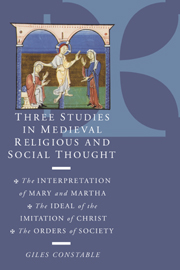 Three Studies in Medieval Religious and Social Thought
Three Studies in Medieval Religious and Social Thought Book contents
- Frontmatter
- Contents
- List of illustrations
- Preface
- List of abbreviations
- I THE INTERPRETATION OF MARY AND MARTHA
- II THE IDEAL OF THE IMITATION OF CHRIST
- III THE ORDERS OF SOCIETY
- Introduction
- The early Middle Ages
- The eleventh and twelfth centuries
- From the twelfth century to the end of the Middle Ages
- Appendix: mediocres (mediani, medii) in the Middle Ages
- Bibliography of secondary works
- Index of manuscripts
- Biblical index
- General index
Appendix: mediocres (mediani, medii) in the Middle Ages
Published online by Cambridge University Press: 08 December 2009
- Frontmatter
- Contents
- List of illustrations
- Preface
- List of abbreviations
- I THE INTERPRETATION OF MARY AND MARTHA
- II THE IDEAL OF THE IMITATION OF CHRIST
- III THE ORDERS OF SOCIETY
- Introduction
- The early Middle Ages
- The eleventh and twelfth centuries
- From the twelfth century to the end of the Middle Ages
- Appendix: mediocres (mediani, medii) in the Middle Ages
- Bibliography of secondary works
- Index of manuscripts
- Biblical index
- General index
Summary
in many of the medieval tripartite divisions of society, some people were seen as between others who were either below or above them or, occasionally, on the right or left. They were referred to as mediocres or, more rarely, as mediani or medii, and were contrasted with people described on one side as great, powerful, rich, noble, or best and on the other as little, weak, poor, humble, and low. It is the purpose of this appendix to look at these mediocres and the categories to which they belonged and, more particularly, to see whether they constituted a middle class or prepared the way for the later idea of a middle class.
The term mediocris was used in various types of works in late Antiquity. In the Theodosian Code it appeared in edicts and decrees dealing with taxes and had a primarily economic meaning. The mediocres were contrasted with the potiores in 324, with the ditiores and infimi in 328, and with the opulentes in 400 and 405. In 417 tax relief on abandoned lands was granted only on lands ‘of which the lords do not exist or are mediocres in poverty and are shown to have only those lands’. People of middling fortune were distinguished from the more noble in the Code of Justinian, and a free man of middling place (mediocris loci ingenuus) from the lord of an estate. These texts show that for lawyers and administrators in the fourth and fifth centuries mediocris was a recognized term for a person who was relatively far down, but well above the bottom, of the social and economic scale.
- Type
- Chapter
- Information
- Three Studies in Medieval Religious and Social ThoughtThe Interpretation of Mary and Martha, the Ideal of the Imitation of Christ, the Orders of Society, pp. 342 - 360Publisher: Cambridge University PressPrint publication year: 1995


